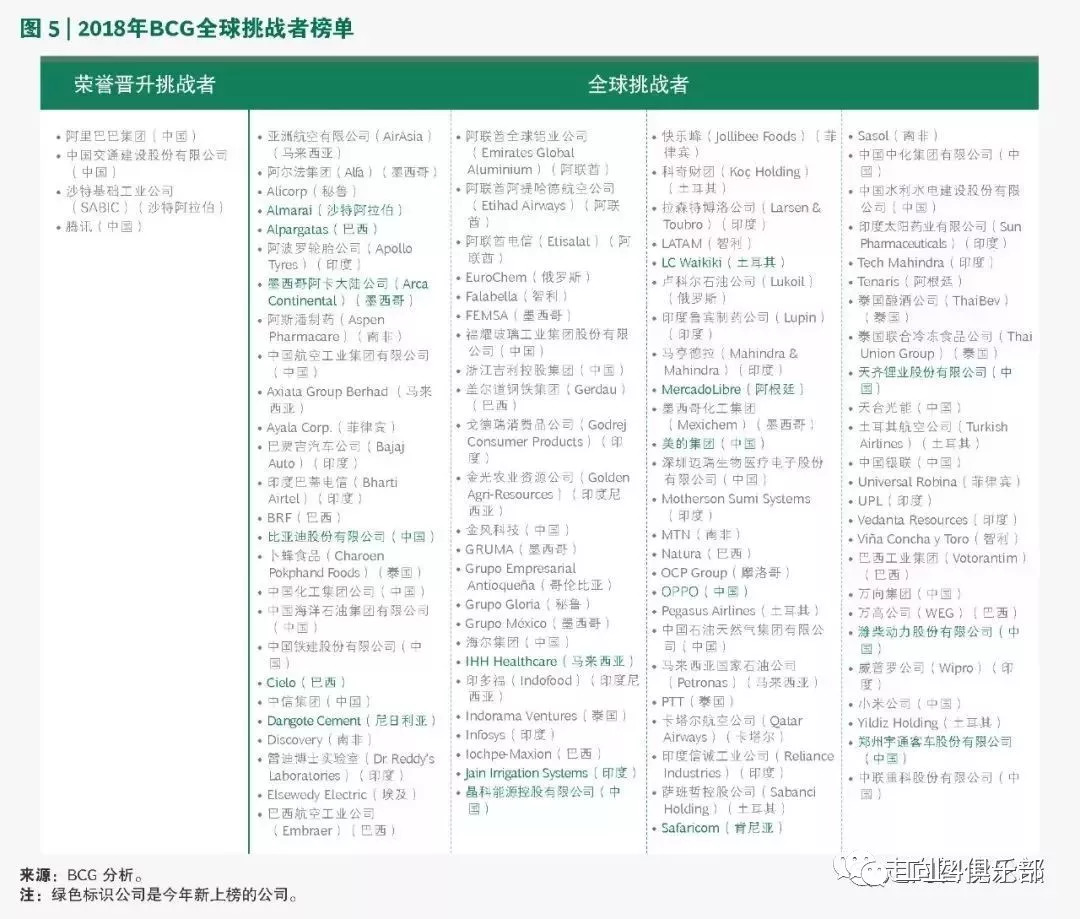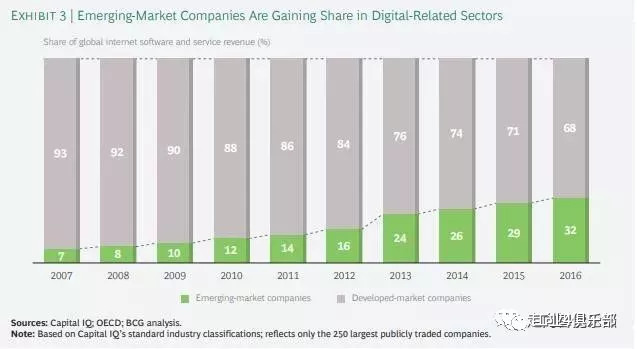On August 8, the Boston Consulting Group (BCG), a world-renowned consulting firm, released the report "2018 BCG Global Challengers: Digital Leapfrogs" (2018 BCG Global Challengers: Digital Leapfrogs), and announced the year of 2018. "Global Challenger" Top 100 list. The report pointed out that as consumers and businesses in emerging markets actively use online technologies and tools, emerging markets have become an important position for nurturing digital leaders.
According to the report, nearly 60% of the companies in the list of the top 100 global challengers in 2018 were either digital native companies or digital technology users. Compared with 2012, only 17% of companies applied digital technology extensively. These global challengers from emerging markets are quickly catching up with their counterparts in mature markets and gradually establishing their leading positions.

2018 list of the top 100 global challengers
The four companies have been promoted to global leaders. Among them, Alibaba and Tencent have established their own digital empires, radiating their influence locally and even globally, and are ready to compete with Amazon, Google, Facebook, etc. at any time.

In the list of the top 100 in 2018, a total of 28 companies from China made the list. Among them, there are a total of 17 new members on the list. Chinese companies occupy 7 seats. They are: electric vehicle manufacturer BYD, crystalline silicon photovoltaic module supplier JinkoSolar, electrical appliance manufacturer Midea Group, mobile phone manufacturer OPPO, and lithium battery products. Supplier Tianqi Lithium, heavy machinery and construction equipment manufacturer Weichai Power, and internal combustion engine and electric bus manufacturer Yutong Bus.
Digital influence is increasing day by day
Chen Qinglin, partner of BCG and head of the Greater China Region of the Global Advantage Project, said that BCG believes that global challengers have been accurately positioned and know how to use their digital assets and technological advantages to fully grasp the many characteristics of emerging markets and benefit from them. For example, emerging markets are still experiencing high population growth and economic growth that are unique on a global scale. Global challengers can open up territory with their high efficiency and value-based productivity. He believes that consumer-centric companies are more likely to have access to consumer groups that are familiar with digitalization and accept new technologies, and the scale of this group is still expanding. Decision-making departments and regulatory agencies in many developing countries are beginning to create a more relaxed regulatory environment for digital innovation, which promotes the development of digital talents, collaboration within the digital ecosystem, and economic growth.
To be selected as a "Global Challenger" company, it must have at least US$1 billion in annual revenue, more than 1,000 employees, and a growth rate that exceeds its domestic market GDP or industry average, and its EBIT ratio must be equal to or exceed the industry average .
BCG has identified three categories for challengers from emerging market companies: digital natives (ie, digitally-born companies), digital adopters (those adopting digital technology as an integral part of their business models), and traditional companies (those who may Companies pursuing some digital plans). In the 2018 list, nearly 60% of the companies are digital natives or important digital adopters.

Digital technology is widely used in the following fields:
Industrial products and manufacturing. Industry 4.0 technology counters the rebalancing of global supply chains and rising wages in manufacturing centers in emerging markets.
Consumer products. E-commerce and omni-channel sales and distribution make up for the lack of modern trade channels in many cities.
Technology, media and telecommunications. The infrastructure, hardware and software of the mobile-first environment surpassed the PC as the main way of surfing the Internet.
energy. Renewable energy and high-efficiency power grids solve the pollution problem of megacities in emerging markets.
health care. Digital medical services help cope with limited hospital capacity and growing epidemics such as diabetes.
Financial Services. Fintech products and services are rapidly becoming popular in markets where people have neither credit cards nor credit history.
Four characteristics of digitization
The report analyzes the application of digital technology by the "Global Challenger" and draws the following four common characteristics.
First, they use emerging technologies such as Industry 4.0 and Service 4.0 to increase productivity and optimize their core business. The transition to Industry 4.0 is a global phenomenon, and emerging market companies often use this trend as an opportunity for them to gain a greater share of value-added in the global value chain.
Second, "Global Challengers" pay close attention to customers and consumers who are highly involved in digitalization. This move can promote economic growth and innovation. Focus on digital customer experience, provide personalized services, strengthen customer engagement, and establish long-term cooperative relationships with customers.
Third, pursue business model innovation, set foot in a new digital business field, and establish a new model to break the existing value pool. The report emphasizes that breaking conventions is no longer a phenomenon unique to mature markets. Even in a relatively young market, newcomers can surpass the status quo with new technologies and new capabilities.
Fourth, embedded "digital drivers". "Global challengers" are not limited to the application of digital technology, they are also embedding new technologies throughout the organization to empower themselves.
Three Ways of Advanced Digital Technology Development
The report shows that global challengers generally develop their digital capabilities in three main ways:
Internal innovation and research and development. Heavy investments in internal digital innovation and R&D have led global challengers and emerging market companies to generally catch up with technological leadership, even if not in leapfrog developed countries. Huawei (Huawei) is one of the representatives. From 2012 to 2016, it applied for 4,000 to 6,000 unique patents every year-at least twice as high as many top Western technology companies. Huawei focused on research and development, and completed the leap from a follower of the communications equipment industry to a leader in the industry in just 5 years, doubling its revenue and market share.
Partnerships and ecosystems. Many emerging market participants are working with other companies to build a digital ecosystem. Tencent utilizes a broad-based digital ecosystem to provide users with comprehensive value-added services and achieves its outstanding scale and engagement on social media. Alibaba's Ant Financial has created a global smart payment ecosystem through cooperation with merchants, banks and other financial technologies. Xiaomi has built a large smart home ecosystem, focusing on home appliances, healthcare and entertainment.
M&A and private investment. Leading emerging market players are seeking strategic investments to expand their business or build new capabilities faster. Many of these transactions have a technical component—that is, they generally have two technology companies or non-tech companies acquiring technology or technical capabilities. Globally, the proportion of technology company acquirers in non-technology sectors has increased by 9 percentage points since 2012, accounting for about 70% of all technology transactions.
HIGH QUALITY:Made of only the highest quality materials and built to last! Our chargers are gauranteed to match the original brand name chargers' quality.
EASY TO USE: Simply plug the charger into a wall outlet and then directly into your scooter.
The charger protected: Short circuit protection/ over current protection/ over voltage protection; red light -- charging, green light -- charge OK, it stop automatically when the battery is full. Warm Tips: To avoid the temperature of your charger too high, please do not charge too long.
The shell is made by high-quality plastic, smooth appearance with no impurities. Good safety performance, more reliable for you to use. Red light means charging; Green light means fully charged or disconnect.Aviation Plug Scooter Charger,Power Scooter Charger,Li-Ion Battery Charger
Shenzhen Waweis Technology Co., Ltd. , https://www.huaweishiadapter.com